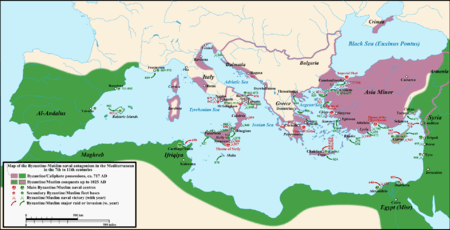Sack of Damietta (853)
| Sack of Damietta | |||||||
|---|---|---|---|---|---|---|---|
| Part of the Arab–Byzantine Wars | |||||||
 Map of the Arab–Byzantine naval conflict in the Mediterranean, 7th–11th centuries | |||||||
| |||||||
| Belligerents | |||||||
| Byzantine Empire | Abbasid Caliphate | ||||||
| Commanders and leaders | |||||||
| "Ibn Qatuna" | unknown | ||||||
| Strength | |||||||
| 85 ships, 5,000 men | unknown | ||||||
The Sack of Damietta in 853 was a major success for the Byzantine Empire. On 22 May 853, the Byzantine navy attacked the port city of Damietta on the Nile Delta, whose garrison was absent at the time. The city was sacked and plundered, yielding not only many captives but also large quantities of weapons and supplies intended for the Emirate of Crete.
Background
During the 820s, the Byzantines had suffered two great losses that destroyed their naval supremacy in the Mediterranean: the beginning of the Muslim conquest of Sicily and the fall of Crete to Andalusian exiles. These losses ushered an era where Saracen pirates raided the Christian northern shores of the Mediterranean almost at will. The establishment of the Emirate of Crete, which became a haven for Muslim ships, opened the Aegean Sea up for raids, while their—albeit partial—control of Sicily allowed the Arabs to raid and even settle in Italy and the Adriatic shores.[1] Several Byzantine attempts to retake Crete in the immediate aftermath of the Andalusian conquest, as well as a large-scale invasion in 842/843, failed with heavy losses.[2]
Byzantine expedition and sacking of Damietta
Thus, in 852/853, the Byzantine government tried a new approach: it assembled a huge naval armament, reportedly of three fleets consisting of 300 ships, and sent them to raid Muslim naval bases in the Eastern Mediterranean simultaneously. One of these fleets, comprising 85 ships and 5,000 men under a general known from Arab sources only as "Ibn Qatuna", headed for the Egyptian coast, for it was from Egypt that the Abbasids sent aid to Crete.[3][4] Various identifications have been proposed by modern scholars for "Ibn Qatuna", but without any firm evidence. Henri Grégoire originally suggested Sergios Niketiates, who however probably died in 843, and later with the parakoimomenos Damian. Further suggestions include Constantine Kontomytes and the strategos Photeinos.[5]
The Byzantine fleet arrived before the city on 22 May 853. At the time, the garrison was absent, attending a feast organized by the governor 'Anbasa ibn Ishaq al-Dabbi in Fustat. Damietta's inhabitants fled the undefended city, which was plundered for two days and then torched by the Byzantines. The Byzantines carried off some six hundred Arab and Coptic women, as well as large quantities of arms and other supplies intended for Crete.[6] They then sailed east and attacked the strong fortress of Ushtun. After taking it, they burned the many artillery and siege engines they found there and returned home.[7]
Impact
Although "one of the brightest military operations" (Christides) undertaken by the Byzantine military, the raid is completely ignored in Byzantine sources, whose accounts are warped by their hostile attitude to Michael III (reigned 842–867) and his reign. Consequently, the raid is known only through two Arab accounts, by al-Tabari and Ya'qubi.[3][8]
According to the Arab chroniclers, the realization of Egypt's vulnerability from the sea led, after a long period of neglect, to the urgent strengthening of Egypt's maritime defences: ships were constructed, new crews conscripted, and Damietta and other coastal sites fortified. This marked the rebirth of the Egyptian navy, which reached its peak later under the Fatimids.[7][9]
References
- ↑ Pryor & Jeffreys 2006, pp. 46–49; Whittow 1996, pp. 151–152.
- ↑ Bury 1912, pp. 289–292; Pryor & Jeffreys 2006, pp. 46–47.
- 1 2 Bury 1912, p. 292.
- ↑ Pryor & Jeffreys 2006, p. 47.
- ↑ PmbZ, Ibn Qaṭūnā (#2651).
- ↑ Bury 1912, pp. 292–293.
- 1 2 Bury 1912, p. 293.
- ↑ Christides 1984, p. 164.
- ↑ Christides 1984, pp. 52ff.
Sources
- Bury, John Bagnell (1912). A History of the Eastern Roman Empire from the Fall of Irene to the Accession of Basil I (A.D. 802–867). London: Macmillan and Company.
- Christides, Vassilios (1984). The Conquest of Crete by the Arabs (ca. 824): A Turning Point in the Struggle between Byzantium and Islam. Athens: Academy of Athens.
- Lilie, Ralph-Johannes; Ludwig, Claudia; Zielke, Beate; Pratsch, Thomas, eds. (2013). Prosopographie der mittelbyzantinischen Zeit Online. Berlin-Brandenburgische Akademie der Wissenschaften. Nach Vorarbeiten F. Winkelmanns erstellt (in German). De Gruyter.
- Pryor, John H.; Jeffreys, Elizabeth M. (2006). The Age of the ΔΡΟΜΩΝ: The Byzantine Navy ca. 500–1204. Leiden and Boston: Brill Academic Publishers. ISBN 978-90-04-15197-0.
- Whittow, Mark (1996). The Making of Byzantium, 600–1025. Berkeley and Los Angeles: University of California Press. ISBN 0-520-20496-4.
Further reading
- Kubiak, Władyslaw B. (1970). "The Byzantine Attack on Damietta in 853 and the Egyptian Navy in the 9th Century". Byzantion. 40: 45–66. ISSN 0378-2506.
- Levi della Vida, Giorgio (1944). "A papyrus reference to the Damietta raid of 853 A.D.". Byzantion. 17: 212–221. ISSN 0378-2506.
- Rémondon, Roger (1953). "A propos de la menace byzantine sur Damiette, sous le règne de Michel III". Byzantion (in French). 23: 245–250. ISSN 0378-2506.